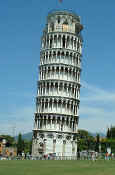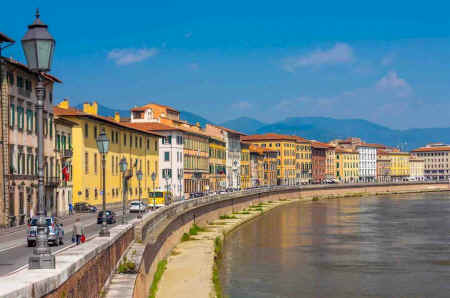|
The Tower consists of a cylindrical body of masonry encircled by arcades composed arches and columns, resting
on the base and surmounted by a belfry. The building we see today is the result of
numerous attempts at restoration carried out over the centuries to reduce the risk of collapse resulting from the
Tower's inclination.
The central body of the structure is composed of a hollow cylinder, formed by an external wall facing of shaped ashlars in white and grey San Giuliano limestone, an inner wall facing also of worked limestone and, between these two wall facings, an annular masonry area. Within this masonry area is a spiral
staircase of 293 steps that climbs up to the sixth arcade, where the internal well terminates in a vault with a central aperture for the passage of light, allowing access to the belfry above and, in the lower intermediate areas, to the various arcades.
|

|
|
The six arcades, the base on which they are placed and the belfry above them subdivide the Tower into eight segments, known as orders. The interior order is animated by a band of blind arches placed on half columns. Underneath the arches are lozenged rhomboid decorations inlaid with coloured marbles, each containing a rosette in relief at the centre.
The wall facing is interrupted by narrow round-arched lancet windows and, to the west, by the only door of access: a rectangular opening framed by an architrave. Above the architrave a falcate arch with a carved archivolt rests upon two capitals in continuation of the piers, forming an aedicule containing a fourteenth-century bust of the Madonna and Child.
At the sides of the portal there are friezes with decorations showing animals, imaginary
beasts and ships. The cylindrical belfry which caps the Tower, of a smaller diameter than the floors below, bears an external decoration composed of closed and pierced lunettes, which rest alternately on pedestals and columns, whereby under every pedestal (bearing two closed lunnettes) there is a door, while the single pierced lunnettes supported on columns are lengthened to form windows. The belfry is reached via a narrow spiral stair, and in turn allows access to the
top of the tower by way of a stair cut into the wall.
The architect of the Tower
An inscription to the right of the entrance door records the date on which
construction of the Tower began. A.D. MCLXXIV. CAMPANILE HOC FUIT FUNDATUM MENSE AUGUSTI (in the month of August, A.D. 1174, this bell tower was founded). This evidence is confirmed in the contemporary chronicles of Bernardo
Maragone. The name of the architect, however, is not recorded. Vasari identified
him as Bonanno Pisano but recent research points to Diotisalvi - the architect of the Baptistery. The
name Diotisalvi occurs in a document of 1174 and there are evident affinities between the structure of the Baptistery and that of the Tower. The
'double' structure based on a correlation between interior and exterior is very similar in the two buildings.
Another, perhaps more likely, candidate is Biduino, who was active at that time in the area of
Pisa. The decorations of the base order are very similar to Biduino's most well-known work. However,
there are no corroborating documents and the identity of the architect of the Tower
remains to be resolved.
|
Churches, palaces and piazzas of Pisa
Knights' Square (Piazza dei Cavalieri), location of the Palazzo della
Carovana. Its splendid faηade was designed by Giorgio Vasari.
The Church of Santo Stefano dei Cavalieri, also by Vasari is in the
same piazza. It originally had a single nave but two more were added in the
17 C. It houses a bust by Donatello a paintings by Vasari, Jacopo Ligozzi, Alessandro Fei and Jacopo da Empoli.
The Church of St. Francis was designed by Giovanni di Simone and built after 1276. In 1343, new chapels were added and the church was elevated. It has a single
nave and a notable belfry, as well as a 15 C cloister. It houses works by Jacopo da Empoli, Taddeo Gaddi and Santi di Tito. Ugolino della Gherardesca and his
sons are buriied in the Gherardesca Chapel.
The Church of San Frediano is recorded for the first time in 1061. It has a basilica interior with three aisles, with a crucifix from the
12 C. The paintings are mostly from the 16 C restoration, and include works by Domenico Passignano, Aurelio Lomi and Rutilio Manetti.
The Church of San Nicola, the existence of which was recorded as early as
1097, was enlarged between 1297 and 1313 by the Augustinians, perhaps
following a design of Giovanni Pisano. The octagonal belfry is from the second half of the
13 C. The paintings include a Madonna with Child by Francesco Traini (14
C) and St. Nicholas Saving Pisa from the Plague (15 C). The wood sculptures by Giovanni and Nino Pisano, and the Annunciation by Francesco di
Valdambrino are also worth attention.
The small Church of Santa Maria della Spina, attributed to Giovanni Pisano (1230), is another excellent Gothic building.
The Palazzo della Carovana or dei Cavalieri, built by Vasari.
The Church of San Paolo a Ripa d'Arno, founded around 952. It was enlarged in the
mid-12 C along lines similar to those of the Cathedral. For the pale grey marble decoration ancient Roman marbles were used. The faηade was completed in the
14 C by Giovanni Pisano. It houses frescoes by Buffalmacco and Turino Vanni
(14 C). It is annexed to the Romanesque Chapel of St. Agatha, an octagonal-plan, brick construction of the
12 C, with an unusual pyramidal cusp or peak.
The Borgo Stretto, a neighborhood where one can stroll beneath
mediaeval arcades and the Lungarno, the avenues along the river Arno. It includes the Gothic-Romanesque
Church of San Michele in Borgo (990). Remarkably, there are at least two other leaning towers in the city, one at the southern end of central Via Santa Maria, the other halfway through the Piagge riverside promenade.
The Medici Palace, once a possession of the Appiano family, who ruled Pisa in 1392-1398. In 1400 the
Medici
family acquired it, and Lorenzo de' Medici soujourned here.
The Palazzo Reale ("Royal Palace"), once of the Caetani patrician family. Here Galileo Galilei showed to Grand Duke of Tuscany the planets he had discovered with his telescope. The edifice was erected in 1559 by Baccio Bandinelli for Cosimo I de Medici, and was later enlarged including other palaces.
Palazzo Gambacorti, a Gothic building of the 14th century, is now the Town hall. The interior shows frescoes boasting Pisa's sea victories.
Pisa
Museums
Museo dell' Opera del Duomo exhibits among others the original sculptures of Nicola Pisano and Giovanni Pisano and the treasures of the cathedral.
Museo delle Sinopie displays the sinopias from the camposanto, the monumental cemetery. These are red ocher underdrawings for frescoes, made with reddish, greenish or brownish earth colour with water.
Museo Nazionale di S. Matteo exhibits sculptures and painting from
12 C to 15 C, among them the masterworks of Giovanni and Andrea Pisano, the Master of San Martino, Simone Martini, Nino Pisano and Masaccio.
The Museum of the Ancient Ships of Pisa is promised for 2009 - more
about the Roman ships here.
|

